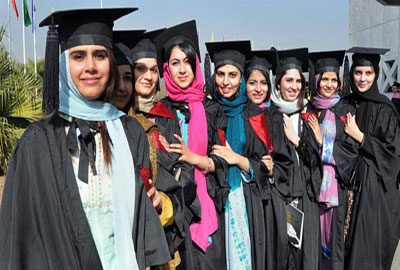Female education is a catch-all term for a complex of concerns and debates surrounding education (primary education, secondary education, tertiary education and health education in particular) for females. It involves areas of gender equality and access to education, and its relation to the alleviation of poverty. Also included are the issues of single-sex education and religious education, in that the division of education along gender lines, and religious teachings on education, have been traditionally dominant, and are still highly relevant in contemporary discussion of female education as a global consideration.
While the feminist movement has definitely promoted the importance of the concerns attached to female education, discussion is wide-ranging and by no means confined to narrow terms of reference: it includes for example AIDS. Universal education, meaning state-provided primary and secondary education independent of gender, is not yet a global norm, even if it is assumed in most developed countries.
Current Trends
In the developed world, women have exceeded men at many levels of education. For example, in the United States in 2005/2006, women earned 62% of Associate’s degrees, 58% of Bachelor’s degrees, 60% of Master’s degrees, and 50% of Doctorates.
Education for women with handicaps has also improved. In 2011, Giusi Spagnolo became the first woman with Down Syndrome to graduate college in Europe (she graduated from the University of Palermo in Italy.)
Improving girls’ educational levels has been demonstrated to have clear impacts on the health and economic future of young women, which in turn improves the prospects of their entire community. In the poorest countries of the world, 50% of girls do not attend secondary school. Yet, research shows that every extra year of school for girls raises their lifetime income by 15%. Developing female education, and thus women’s earning potential, improves the standard of living for their own children, as women invest more of their income in their families than men do. Yet, many obstacles to education for girls remain. In some African countries, such as Burkina Faso, girls are unlikely to attend school for such basic reasons as a lack of private latrine facilities for girls.
Higher rates of high school and university education among women, particularly in developing countries, have helped them make inroads to professional careers and better-paying salaries and wages. Education raises a woman’s (and her partner and the family’s) level of health and health awareness. Furthering women’s levels of education and advanced training also tends to lead to later ages of initiation of sexual activity and first intercourse, later age at first marriage, and later age at first childbirth, as well as an increased likelihood to remain single, have no children, or have no formal marriage and alternatively, have increasing levels of long-term partnerships. It can lead to higher rates of barrier and chemical contraceptive use (and a lower level of sexually transmitted infections among women and their partners and children), and can increase the level of resources available to women who divorce or are in a situation of domestic violence. It has been shown, in addition, to increase women’s communication with their partners and their employers, and to develop rates of civic participation such as voting or the holding of office.
